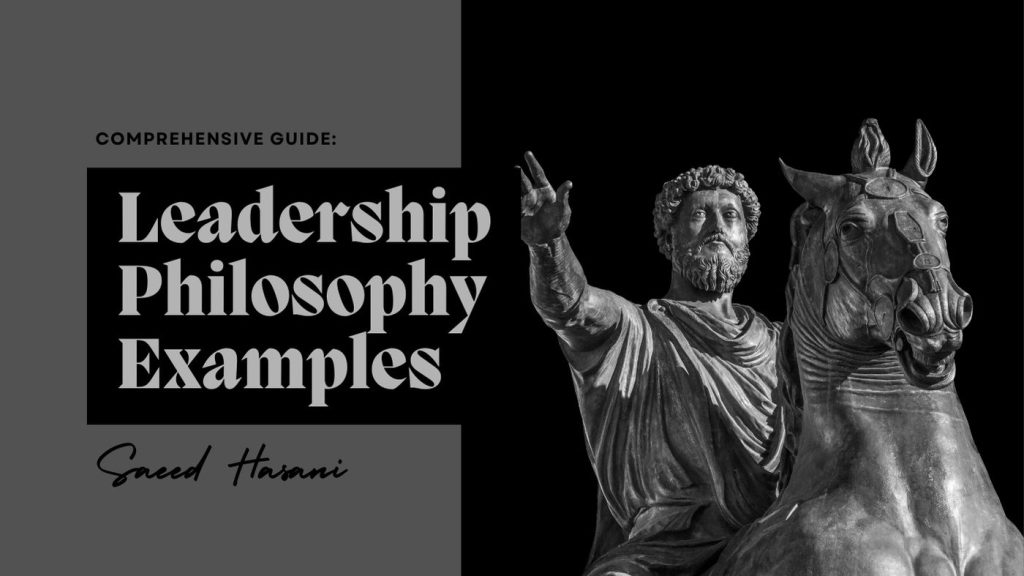27 Leadership Philosophy Examples: Comprehensive Guide!

Are you on the journey to becoming a more effective leader but not sure where to start? Discover the power of a well-defined leadership philosophy with our comprehensive guide, featuring 27 inspiring leadership philosophy examples.
Unlock the secrets to guiding your team with confidence, improving communication, and boosting overall performance by crafting a philosophy that resonates with your core values and leadership style.
Content Overview:
What is a Leadership Philosophy?
A leadership philosophy is a set of beliefs and principles that guide a leader’s actions, decisions, and interactions with others. It reflects how a leader views leadership, their role as a leader, and how they intend to lead others.
This philosophy is shaped by personal values, experiences, and the context in which leadership is exercised. Here are some key elements often found in a leadership philosophy:
- Core Values: These are the fundamental beliefs that guide a leader’s behavior and decision-making process. Values such as integrity, respect, and accountability are commonly emphasized in leadership philosophies.
- Vision and Purpose: A clear vision for where the leader wants to guide their team or organization, and the purpose behind their leadership. This includes long-term goals and the impact the leader aims to achieve.
- Leadership Style: This includes how a leader interacts with their team, make decisions, solve problems, and motivate and support their team members. Styles can range from authoritative to democratic, coaching, or transformational, depending on what the leader believes is most effective.
- Communication: How a leader plans to communicate with their team and stakeholders, including the level of openness, frequency, and methods of communication.
- Commitment to Growth: This covers both the leader’s personal growth and development, as well as the development of their team members. It includes fostering a culture of continuous learning, feedback, and improvement.
- Ethical Framework: How a leader addresses ethical dilemmas and makes decisions that align with both personal and organizational values.
- Approach to Challenges: How a leader plans to address obstacles and failures, including resilience, adaptability, and the strategy for problem-solving and conflict resolution.
Having a clear leadership philosophy is important because it helps leaders navigate complex situations, provides a consistent framework for making decisions, and helps inspire and guide others.
It also facilitates transparency and builds trust within teams, as team members understand the rationale behind their leader’s actions and decisions.
Why is a Leadership Philosophy Important?
A leadership philosophy is important for several compelling reasons, as it serves as a foundational guide that shapes the way leaders approach their roles, interact with teams, and influence their organizations. Here are key reasons why developing and maintaining a clear leadership philosophy is critical:
- Provides Direction and Purpose: A leadership philosophy clarifies a leader’s goals, values, and priorities, providing a clear direction and purpose for their actions. This helps in guiding decision-making and setting a coherent path forward for the team or organization.
- Enhances Consistency: It promotes consistency in leadership behavior, ensuring that decisions and actions are aligned with the defined values and principles. This consistency is crucial for building trust and credibility among team members and stakeholders.
- Fosters Effective Communication: Articulating a leadership philosophy helps in establishing clear expectations and enhances communication between leaders and their teams. It makes it easier for team members to understand the leader’s vision, expectations, and reasons behind decisions, which can lead to more effective collaboration and team cohesion.
- Empowers Decision-Making: A well-defined leadership philosophy serves as a compass during challenging times, providing a framework for making tough decisions. Leaders can refer back to their core values and principles to navigate ethical dilemmas, conflicts, and complex situations with confidence.
- Promotes Self-Awareness and Personal Growth: The process of developing a leadership philosophy encourages leaders to reflect on their values, experiences, and the impact they wish to have. This reflection fosters self-awareness and personal growth, enabling leaders to evolve and adapt their leadership approach as needed.
- Builds Organizational Culture: Leadership philosophies play a significant role in shaping organizational culture by modeling behaviors, values, and norms that define the environment. A strong, positive leadership philosophy can inspire a culture of integrity, excellence, innovation, and collaboration.
- Inspires and Motivates Others: A compelling leadership philosophy can inspire and motivate team members by providing a sense of shared purpose and vision. When leaders effectively communicate their philosophy and live by it, they can engender loyalty, enthusiasm, and a high level of engagement among their teams.
- Attracts and Retains Talent: Leaders who clearly articulate their values and how they intend to lead are more likely to attract and retain employees who share similar values and are committed to the vision. This alignment can lead to higher job satisfaction, reduced turnover, and a stronger sense of belonging among team members.
A leadership philosophy is not just about guiding the leader’s own behavior; it’s also about creating an environment that enables others to thrive, fostering a culture of trust, accountability, and excellence, and ultimately contributing to the success of the organization.
What Are the Key Elements of a Leadership Philosophy?
The key elements of a leadership philosophy encapsulate the foundational beliefs, principles, and practices that guide a leader’s approach to leading others. These elements provide a framework for decision-making, interacting with team members, and setting the direction of an organization or team.
- Core Values: The fundamental beliefs that guide a leader’s actions and decisions. These could include integrity, honesty, respect, and commitment to excellence. Core values are the ethical compass that dictates how a leader behaves and makes choices.
- Vision and Mission: A clear articulation of the future the leader seeks to create (vision) and the purpose or reason for the leader’s and organization’s existence (mission). This provides direction and inspiration for the leader and their team.
- Leadership Style: The approach a leader takes in guiding, directing, decision-making, and motivating people. This could range from autocratic to democratic, transformational, servant leadership, or a combination of styles, tailored to the leader’s personality and the needs of the team.
- Communication Strategy: How a leader plans to communicate with their team and other stakeholders. This includes the methods of communication, the frequency, and the level of transparency. Effective communication is key to understanding, collaboration, and building trust.
- Expectations and Goals: Clear expectations for the team’s performance and behavior, along with specific, measurable, achievable, relevant, and time-bound (SMART) goals. This helps in aligning the team’s efforts towards achieving the vision and mission.
- Development and Growth: Commitment to personal growth and the development of team members. This includes fostering a culture of continuous learning, encouraging feedback, and providing opportunities for skill enhancement and professional growth.
- Decision-Making Process: The method by which decisions are made, including the extent to which others are involved in the decision-making process. This element reflects a leader’s balance between autonomy and collaboration.
- Approach to Conflict and Challenges: Strategies for dealing with disagreements, obstacles, and failures. This includes how a leader plans to foster resilience, adaptability, and constructive problem-solving within their team.
- Ethical Considerations: How a leader addresses ethical dilemmas and ensures that actions and decisions align with both personal and organizational ethical standards. This involves promoting integrity, fairness, and accountability.
- Influence and Inspiration: The ways in which a leader intends to inspire, motivate, and positively influence their team members. This could involve leading by example, recognizing and celebrating achievements, and creating an environment where team members feel valued and empowered.
Developing a leadership philosophy requires introspection, clarity, and a deep understanding of one’s values, experiences, and the impact one wishes to have as a leader. It serves as a personal manifesto that guides a leader’s actions and interactions, helping them to lead with purpose, integrity, and effectiveness.
27 Leadership Philosophy Examples
Creating a leadership philosophy is deeply personal and varies widely depending on an individual’s values, beliefs, and experiences.
Below are 27 examples of leadership philosophies to inspire or serve as a foundation for developing your own. Each philosophy reflects different priorities and approaches to leadership.
- Servant Leadership: This philosophy emphasizes serving others as the primary goal of leadership. A Servant leader focuses on the growth and well-being of their team members and the communities to which they belong. They lead by example and prioritize the needs of their team above their own.
- Transformational Leadership: Leaders who adopt this philosophy aim to inspire and motivate their team members to exceed their own limitations and achieve extraordinary outcomes. They focus on creating a vision for the future, encouraging innovation, and fostering a culture of trust and respect.
- Authentic Leadership: Authentic leaders prioritize being genuine and transparent with their team members. They believe in leading with their true selves, acknowledging their vulnerabilities, and building genuine connections with those they lead.
- Ethical Leadership: This philosophy centers around leading with moral principles. Ethical leaders are committed to fairness, integrity, and doing what is right, even in the face of personal or professional challenges.
- Democratic Leadership: Leaders who practice this philosophy believe in making decisions through consensus. They value the input and insights of their team members, fostering an environment of collaboration and mutual respect.
- Autocratic Leadership: This traditional leadership style emphasizes command and control. Leaders make decisions unilaterally, prioritizing efficiency and order, often in environments where quick decision-making is critical.
- Participative Leadership: Similar to democratic leadership, participative leaders actively involve team members in the decision-making process. This approach is believed to increase engagement and foster a sense of ownership among team members.
- Situational Leadership: Leaders adopting this flexible philosophy adjust their style according to the situation and the development level of their team members. They are adept at recognizing what their team needs and adapting their approach accordingly.
- Visionary Leadership: Visionary leaders focus on setting a compelling future vision for their team or organization. They inspire and motivate their team to work towards this vision, driving innovation and change.
- Coaching Leadership: This philosophy is centered around developing team members’ abilities and helping them reach their full potential. Coaching leaders provide guidance, feedback, and support, fostering a culture of continuous learning.
- Inclusive Leadership: Inclusive leaders are committed to diversity, equity, and inclusion. They create environments where different perspectives are valued and everyone feels empowered to contribute their best work.
- Strategic Leadership: Leaders with this philosophy focus on long-term success, aligning resources, and strategic planning to navigate complex challenges and achieve organizational goals.
- Cross-Cultural Leadership: This leadership style emphasizes understanding and bridging cultural differences within global teams. Cross-cultural leaders foster an environment of respect and inclusivity, recognizing the strengths that diverse perspectives bring to the table.
- Resilient Leadership: Resilient leaders focus on developing the ability to withstand and bounce back from challenges and setbacks. They foster a culture of perseverance and adaptability within their teams.
- Inspirational Leadership: Leaders who embrace this philosophy aim to motivate and uplift their team members. They focus on creating a positive and energizing work environment, encouraging their team to achieve beyond what they thought possible.
- Collaborative Leadership: This philosophy prioritizes teamwork and partnership. Collaborative leaders break down silos and encourage cross-functional cooperation to solve complex problems and innovate.
- Hands-On Leadership: Hands-on leaders are deeply involved in the day-to-day operations and work closely with their team. They believe in leading by example and providing direct guidance and support.
- Hands-Off Leadership: In contrast, hands-off leaders trust their team members to work independently. They provide autonomy and freedom, stepping in to offer support and guidance as needed.
- Empowering Leadership: Empowering leaders focus on giving team members the resources, authority, and confidence to take initiative and make decisions. They believe in enabling others to grow and take on leadership roles themselves.
- Ethical Stewardship: Leaders who follow this philosophy are committed to making decisions that benefit all stakeholders, including employees, customers, and the community. They prioritize long-term sustainability over short-term gains.
- Adaptive Leadership: Adaptive leaders are experts in navigating change and uncertainty. They encourage experimentation, learning from failures, and adapting strategies based on new insights.
- Charismatic Leadership: Charismatic leaders rely on their personal magnetism and communication skills to inspire and motivate others. They are often seen as visionary and capable of eliciting strong emotional commitment from their team.
- Pragmatic Leadership: Pragmatic leaders are focused on practical solutions and results. They are flexible in their approach and prioritize effectiveness and efficiency in achieving goals.
- Mindful Leadership: This philosophy emphasizes presence, awareness, and compassion in leadership. Mindful leaders are attuned to their own mental and emotional states and those of their team members, fostering a supportive and productive environment.
- Sustainable Leadership: Leaders adopting this philosophy focus on creating lasting and positive impacts on their organizations and the environment. They integrate social, economic, and environmental considerations into their decision-making processes.
- Pacesetting Leadership: Pacesetting leaders set high-performance standards and lead by example. They are driven and competitive, pushing their teams to achieve high levels of excellence.
- Value-Based Leadership: This philosophy is rooted in leading according to a set of core values. Value-based leaders are consistent, ethical, and transparent, with their actions always aligned with their stated values.
Each leadership philosophy has its strengths and may be more or less effective depending on the context, the leader’s personality, and the needs of the team or organization.
Reflecting on these examples can help you articulate your own leadership philosophy, considering what resonates most with your values and vision for leadership.
How to Write a Leadership Philosophy?
Writing a leadership philosophy is a reflective process that helps clarify your approach to leading others. It serves as a personal manifesto that guides your actions, decisions, and interactions with your team. Here’s a step-by-step guide on how to write a comprehensive leadership philosophy:
1. Reflect on Your Values and Beliefs
- Start by considering your core values and beliefs. What do you stand for? What principles are non-negotiable in your leadership practice?
- Reflect on your experiences, both positive and negative, that have shaped your views on leadership.
2. Identify Your Leadership Style
- Think about how you naturally interact with others. Are you more authoritative, participative, or a mix of different styles?
- Consider how your leadership style has evolved over time and what has influenced these changes.
3. Define Your Vision and Goals
- Articulate a clear vision for the future. What do you want to achieve as a leader? What impact do you want to have on your team and organization?
- Set specific, measurable, achievable, relevant, and time-bound (SMART) goals that align with your vision.
4. Determine Your Approach to People Management
- Consider how you will build relationships with your team members. How will you communicate, provide feedback, and handle conflicts?
- Think about how you plan to motivate and inspire your team to achieve their best work.
5. Plan for Growth and Development
- Reflect on how you intend to foster a culture of continuous learning and development, both for yourself and your team.
- Consider the strategies you will use to encourage innovation and adaptability.
6. Articulate Your Decision-Making Process
- Describe how you will make decisions. Will you involve your team in the decision-making process, or will you make decisions more autonomously?
- Consider how you will ensure that your decisions align with your values and the organization’s goals.
7. Address Ethical Considerations
- Think about how you will navigate ethical dilemmas and ensure that your leadership practices are aligned with ethical standards.
- Describe the measures you will take to promote integrity, transparency, and accountability.
Writing Your Leadership Philosophy
Once you have reflected on these components, begin drafting your leadership philosophy. Keep it concise—aim for one to two pages. Start with an introduction that outlines your core values and beliefs. Then, elaborate on each of the areas mentioned above, providing specific examples when possible. Conclude with a summary of your leadership philosophy and its importance to your approach to leadership.
Tips for Writing Your Leadership Philosophy
- Be Authentic: Ensure your leadership philosophy genuinely reflects who you are as a leader. Avoid using clichés or ideals that sound good but don’t truly represent your values or style.
- Use Clear and Concise Language: Your leadership philosophy should be easy to understand. Avoid jargon and overly complex sentences.
- Reflect Regularly: Your leadership philosophy is not set in stone. As you grow and gain more experience, revisit and revise your philosophy to reflect your evolving insights and priorities.
Your leadership philosophy is a living document that guides your actions and decisions. It communicates to others what they can expect from you as a leader and serves as a foundation for developing effective, inspiring, and ethical leadership practices.
Conclusion
In conclusion, developing a leadership philosophy is an essential step for any leader seeking to clarify their approach to guiding, motivating, and inspiring others.
By reflecting on your core values, leadership style, vision, and strategies for people management, you can craft a philosophy that not only guides your own actions but also fosters a positive and productive environment for your team.
This process not only aids in personal and professional growth but also enhances the overall effectiveness and cohesiveness of the team you lead.
We’d love to hear your thoughts! Do you have a leadership philosophy that guides your actions? How has it evolved over time, and what impact has it had on your leadership style and your team? Share your experiences and insights in the comments below.







Responses